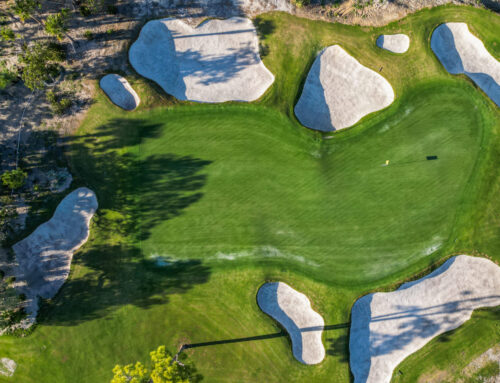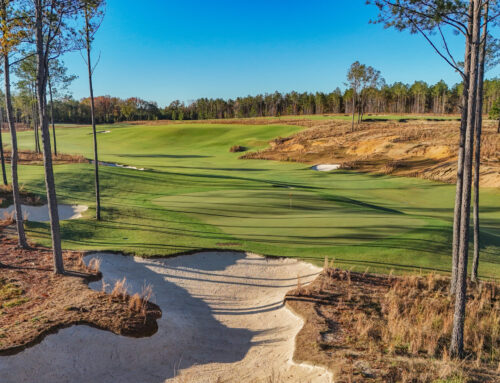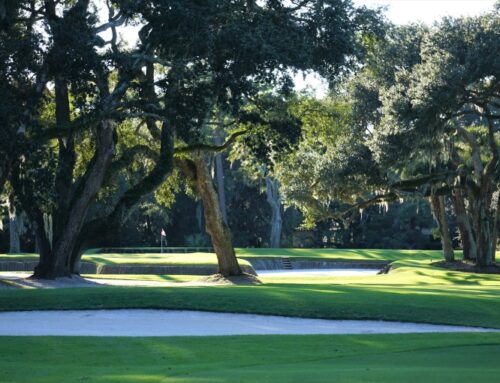Pine Needles
North Carolina, USA
Located on higher land, Pine Needles is a sprawling course, occupying a full 250 acres and is more open to the affects of the wind. The brilliance of Pine Needles lies in how Donald Ross routed the holes across the rolling terrain. The crests of the rolling sand hills continually hit the golfer indifferent ways. Donald Ross draped some holes so that the crest of the hill angles from left to right across the fairway. Thus, on holes like the second and sixth, if the golfer can hug the left side, his tee ball will hit on top of the crest and bound down the far side. Conversely, if he edges down the right hand side (which is the shorter way home), his ball is unlikely to reach the crest and it will die into the hillside with little roll. The difference in the position of two identically struck tee balls with one down the left and one down the right can be as much as forty yards.
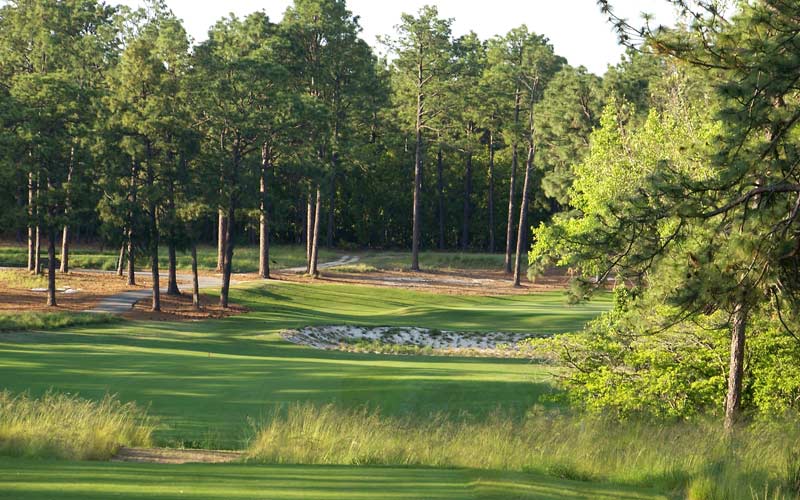
The view from the eleventh tee typifies the rolling nature – and the challenge – at Pine Needles. How well the golfer positions himself off the tee in relation to the crest of the hill likely determines his success on the hole.
Pine Needles’ rolling topography creates a variety of approach shots. For instance, the approach to the fourth is sharply uphill, the approach to the fifth is across a valley and the approach to the sixth is downhill. On the back nine, the tee ball on the eleventh is well downhill, the tee ball on the twelfth is uphill to a crest, and the tee ball on the fourteenth is level but must carry across a valley. Thus, the course progresses along in such a manner with no two holes being similar.
Holes to Note
(Please note: two distances are given below, one from the new back tees which sees Pine Needles stretched to over 7,000 yards and the other from the ‘Donald Ross’ tees, which were the back markers when the course opened in the days of hickory golf.)
First hole, 505/480 yards; Some consider that Donald Ross was the first prolific architect to test each shot and this hole is a fine example. The drive must flirt with the bunker on the inside of this gentle dogleg right, to obtain the shortest route to the green in two.If the player elects to lay up, care must be taken again as a bunker pinches the fairway in sixty yards from the green. Finally, the green complex itself quickly turns two shots into three with any of its right hole locations. The unsuspecting golfer ruefully watches his approach shot hit on the right of this green only to watch it slowly start to drift away, roll off the green and down into the swale or bunker. The resulting recovery shot needs to be played safely to the middle of the green, least the golfer wish to see the ball return to his feet.

As architect Gil Hanse admiringly says, notice how ‘softly’ the holes at Pine Needles sit on the land.

Just three paces to the right of this hole location and a ball ends up in the right greenside bunker.
Second hole, 480/440 yards; Though it is well known that Donald Ross generally defended par at the green, the broad fairways at Pine Needles are among his best for dictating the ideal line. Take the second. As noted above, the crest of the hill angles from left to right across the fairway in the drive zone. If the golfer can hit it down the ‘speed slot’ on the left, his ball can get as much as forty yards more roll than the golfer who goes right,where the ball hits into the hill and dies. As for the green, it is more broad than deep and is open in front. Past the middle, the green gently slopes away from the player. From back at the crest of the hill, the golfer can visualize one of several type approach shots. Too many modern courses accept only one approach shot (a high ball carried to the hole) and it is refreshing to find a course where the ground game remains in favor.

Ross routed the second fairway at a diagonal over the crest of the hill; the shortest carry over the crest is down the left.
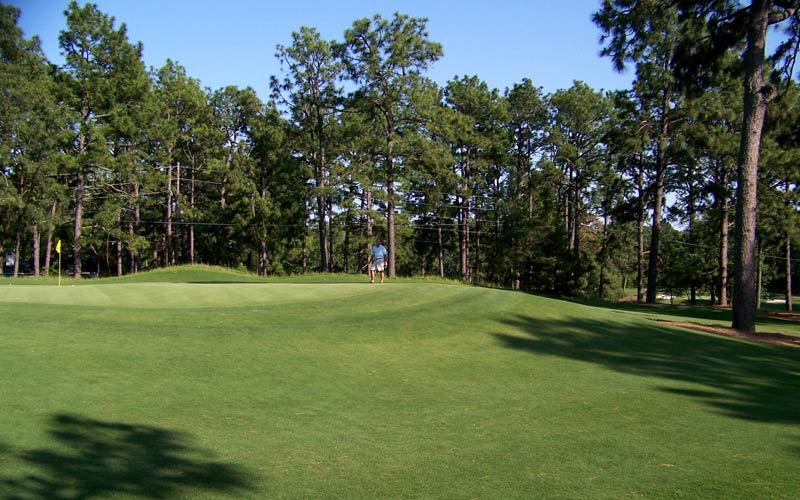
Pre-restoration, a bunker added in the 1970s along the right of the second green would have dominated this photograph. It kept missed approach shots close to the green. Following Ross’s hole diagram, John Fought removed the bunker and balls now kick well away from the green, promoting a greater range in recovery shots.
Third hole, 145/135; The pressure was squarely on Fought when he restored this green. The reason? Because of its photogenic nature, it may well be the most photographed hole ever in Moore County. The abundance of old photographs of this hole from the days when Ross still lived in Pinehurst make it easy to judge the authenticity of Fought’s restoration.
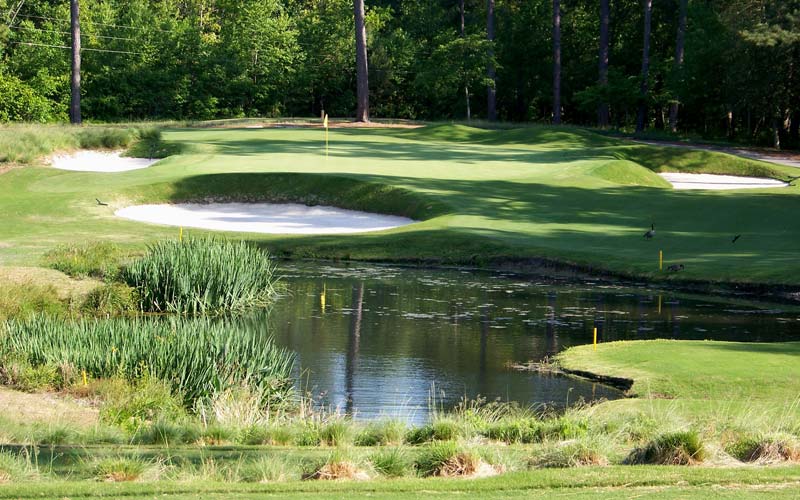
Fought’s restoration returned the third green to Ross’s original drawing, reducing its size by 20% as a front right tongue from the 1970s was removed.
Fourth hole, 405/380 yards; Pine Needles’ lasting trump card over every other course in Moore County is its topography and how Ross’s routing took advantage of it. In this case, the approach shot is abruptly uphill. As it is the only such one on the course, the golfer should appreciate the variety that it adds to the overall challenge.

Unusual for Pine Needles, the tee ball at the fourth is level, albeit over water. The uphill approach requires at least one extra club.
Fifth hole, 220/180 yards; A sturdy one shotter across a valley, one can imagine Ross walking the property for the first time and spotting this hole straightaway. Michael Fay considers it his favorite single Ross one shot hole; strong praise indeed from a man who has played over two hundred Ross courses. This green is of the sort normally associated with Ross in Pinehurst, which is to say it is domed in shape with the high point in the middle of the green. The false front sends many a shot that was just a touch weak trickling back off the green.

The thrilling one shot fifth plays across a valley to a well conceived green complex.

Pine Needles enjoys an intimacy rare for a housing course. Pictured above is the fifth flag, the seventh flag higher to its right, and the back of the eighth tee box.
Sixth hole and Seventh holes, 460/410 and 455/405 yards, respectively; Pine Needles hosted the U.S. Women’s Open in 1995, 2001, and 2007, a rare feat to have a sport’s preeminent event so many times in such a short period. Some of this was in homage to Peggy Kirk Bell, who stays busy at the resort to this day teaching. One natural consequence is that the Pine Needles resort is – logically – closely tied to women’s golf. However, what about Pine Needles as a test for the low handicap male golfer? The sixth and seventh holes clearly dispel the notion that Pine Needles is more about charm than anything else. At over 450 yards each, they play even longer unless the crests of the hills are properly negotiated. Otherwise, the drives hit into the hill and are robbed of needed run. As is evident from the holes selected in this section, the golfer is hard pressed to stay at level fours with the two shot holes at Pine Needles, as many are in the 420 yard plus category. However, Ross never saw value in just beating a golfer into the ground. His three shot holes are not long here and certainly with today’s technology, they give the golfer the opportunity to make up lost ground. This give and take with the golfer has helped make Ross courses appealing for over a century.
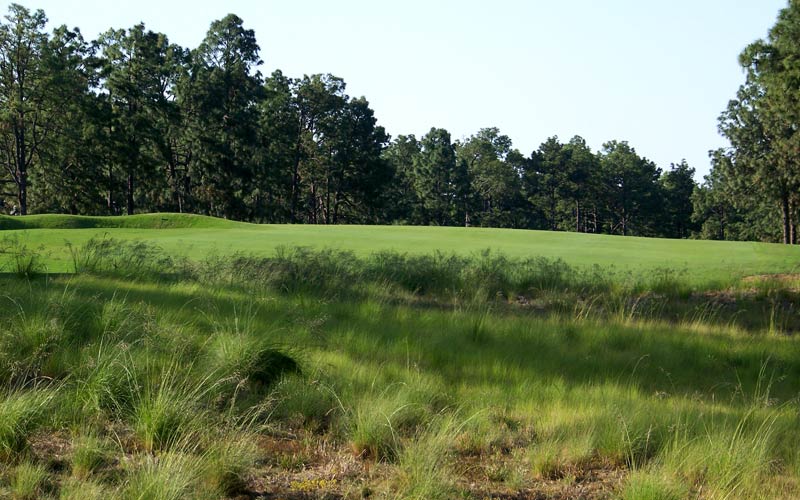
Some of Fought’s best work occurred off the sixth tee, though most golfer’s will never realize it. In an effort to keep Pine Needles current against advances in technology, the hillside was shaved down to accommodate this new back tee which makes the sixth now play 460 yards.

…to a well defended green with everything sloping to this deep right bunker.
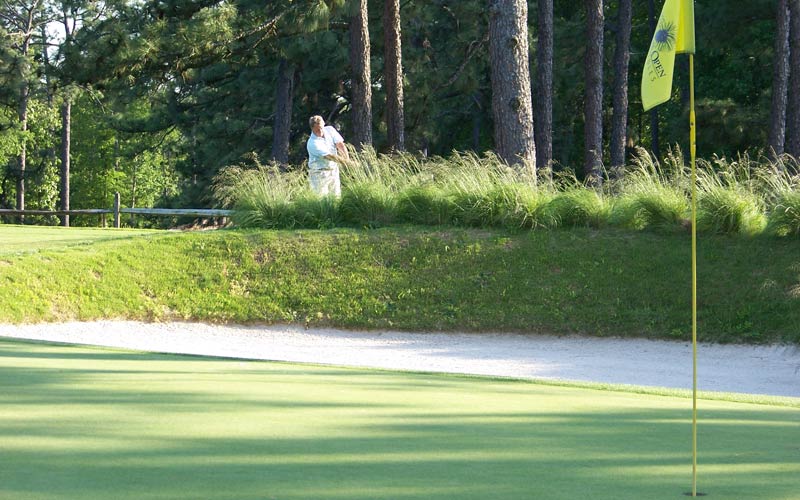
At 7,015 yards, Pine Needles has plenty of length yet only takes 3 1/2 hours to walk. Part of the reason? Short green to tee walks where possible, such as from the seventh green to the eighth tee as seen above.
Eighth hole, 360/355 yards; One of the most improved holes due to Fought’s restoration, the eighth green now features defenses commensurate with the hole’s modest length. The hole was always well routed through a natural valley but prior to 2005, the green complex was one of the least interesting on the course. Fought restored the depth of the green’s primary bunker to over five feet (it was three feet) and recovered some of the green’s back right to front left pitch.
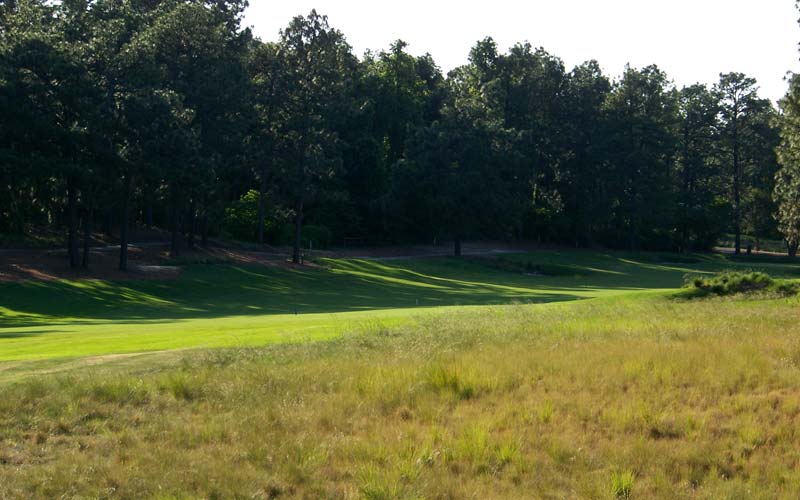
A master at routing holes, no way Ross would miss this natural valley as a spot for a fairway.
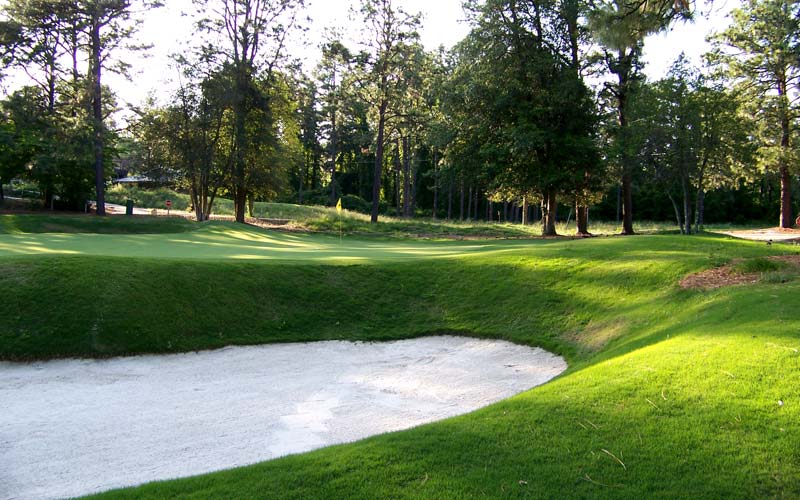
The deepened front right bunker provides appropriate menace for this modest length hole.
Ninth hole, 385/370 yards; One of Ross’s more deceptive holes,the kind sadly lacking in most modern courses. The distance is modest, the fairway is wide and there appears little trouble to be found. However, closer inspection shows the green complex to be full of challenge. All of a sudden, the golfer is best served if he places his tee ball in the right middle of the wide fairway so that he can approach directly down the length of the green. Otherwise, the angles of approach to the narrow green bring into play either the hollow on the right or the enlarged left greenside bunker.
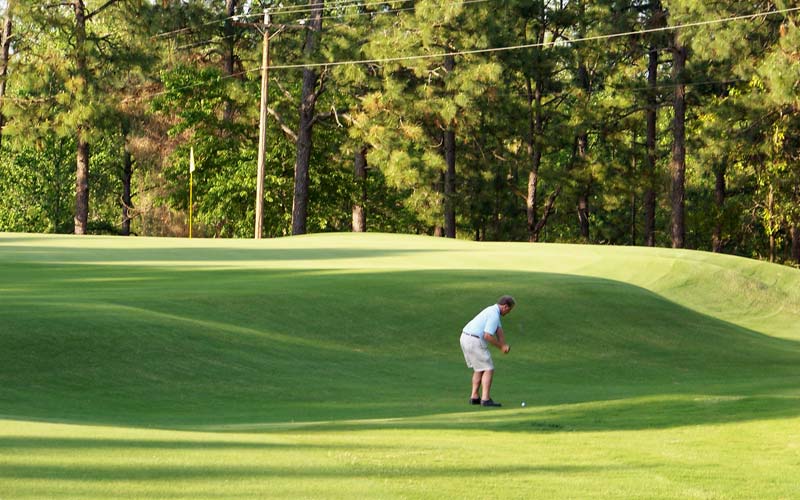
This depression short of the ninth green coupled with the long left back bunker make recovery shots difficult.
Tenth hole, 525/480 yards; One of Ross’s most dramatic bunkers hugs the inside of this dogleg to the left. In recent times, the Bell family has meticulously restored the size and breadth of this oft-photographed bunker to its original dimensions. Those who hope to reach the green in two must flirt with this famed bunker off the tee. Appreciating its risk/reward nature, Johnny Miller proclaimed this to be ‘far and away my favorite hole at Pine Needles’ during the 2007 telecast of the Women’s Open.
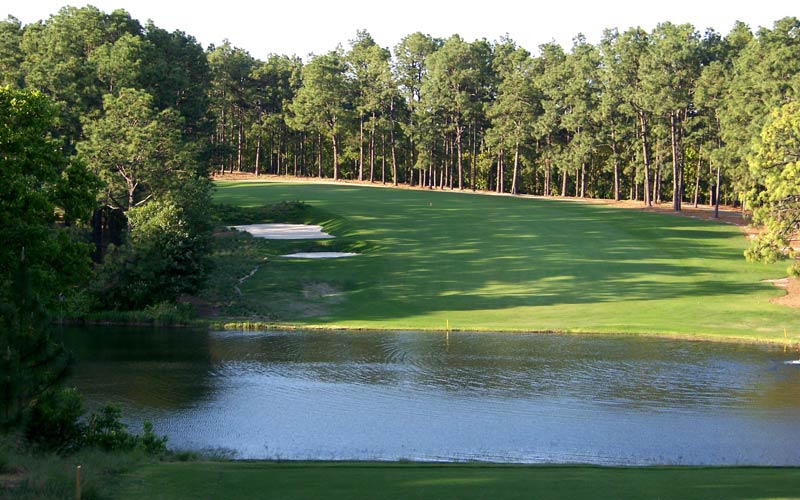
The classic risk reward tenth: can the golfer carry the bunker and set up an eagle?
Eleventh hole, 415/370 yards; Ross magnificently captured the rolling terrain into the playing aspects of this hole. The three high spots of the hole are the tee, the landing area for a good drive and the green. The golfer ideally skips from high spot to high spot in playing this hole and avoids the valleys altogether. The native area of hard pan and wire grass was recaptured during Fought’s 2005 restoration, and the golfer is reminded that he is indeed in the sand hills of North Carolina.
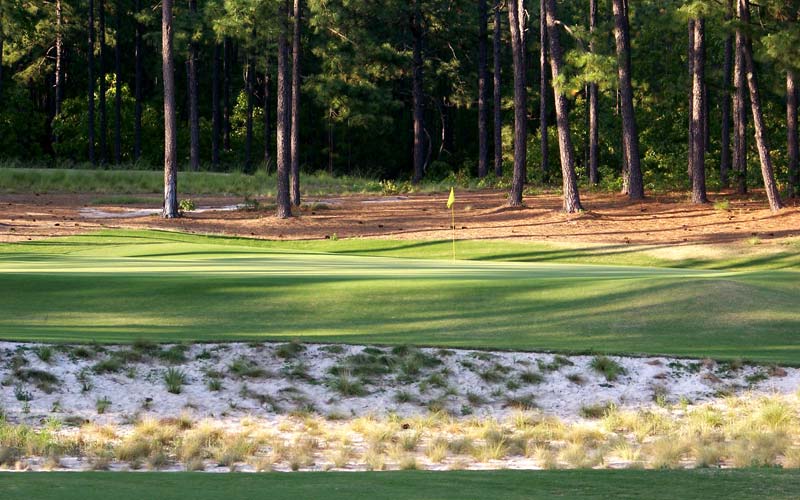
This area was all Bermuda grass prior to Fought’s successful restoration.
Twelfth hole, 410/350 yards; Another hole where the golfer drives to a seemingly wide fairway. Yet once again, there is a preferred angle of approach as the green is open in front only on the right side; an approach from the left hand side must carry gathering greenside bunkers.

The golfer is keenly aware of the rolling nature of the property at Pine Needles in part because Ross didn’t build up his tee boxes. Too many modern architects build tall tee pads which has the unwanted effect of flattening holes from the tee. That is not true here as the crest of the hill is much in evidence from Ross’s twelfth tee.
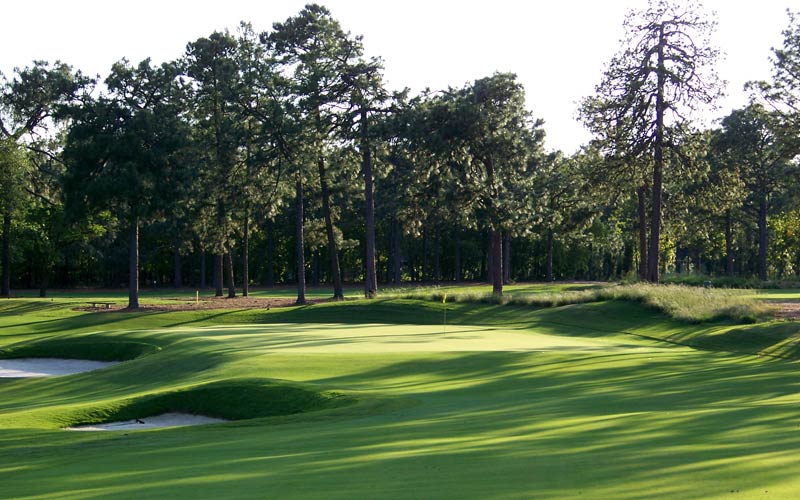
The green complex at the twelfth favors an approach from the right side of the fairway.
Thirteenth hole, 210/180 yards; The deep green combined with the hole’s downhill nature makes club selection crucial. The newly restored bunkers are well in front of the putting surface; the hidden hazard is the swale that rings the narrow green as up and downs are rare if one short sides the hole.
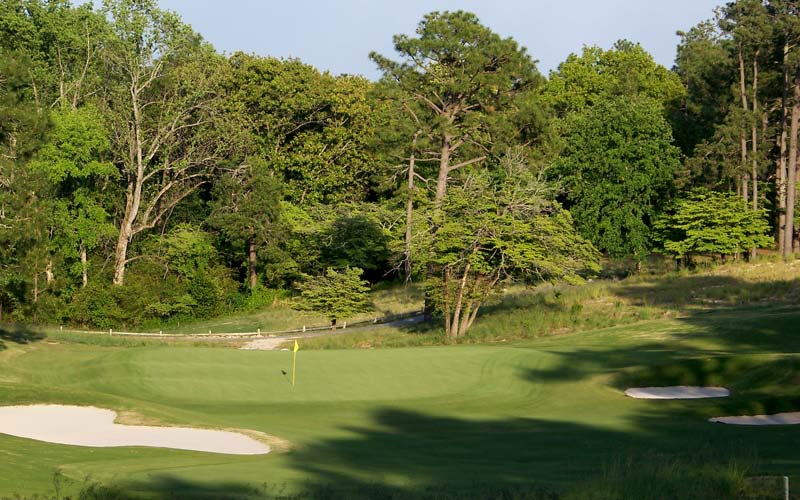
Everyone admires the view from the elevated tee but the hole’s hazards aren’t evident until one gets level to the green. The back right hole location is one of the best on the course.
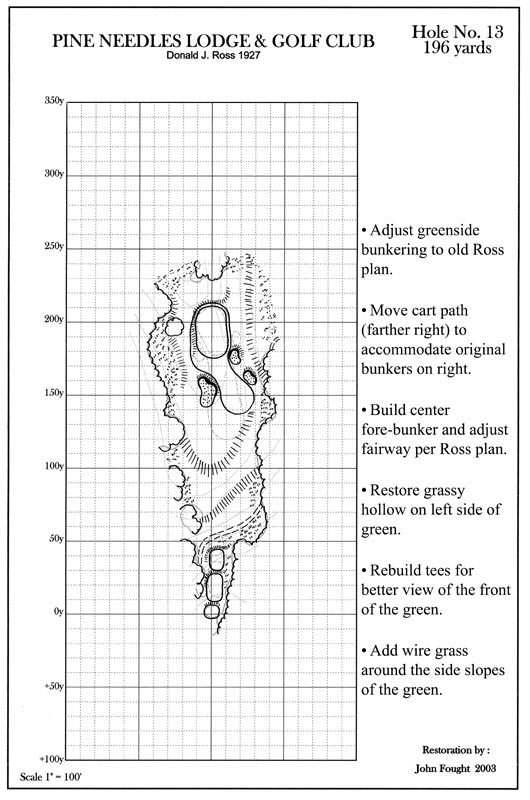
Fought faithfully recaptured Ross’s bunker placement at the thirteenth.
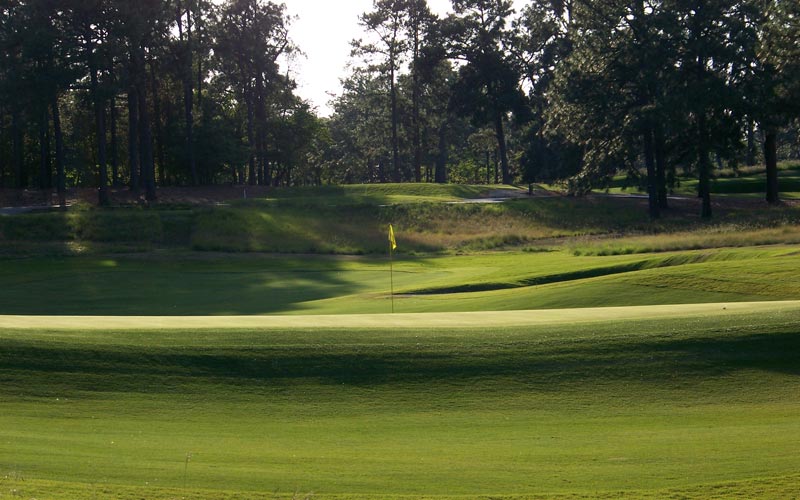
The downhill nature of the thirteenth is captured in the above photograph from behind the green.
Fifteenth hole,530/485 yards; An underrated hole which provides an interesting look back in time.Thirty-five paces from the front edge of the green is a grassy swale. The challenge in the late 1920s was to carry the depression short of the green in two on this three shotter in an effort to set up a birdie. Back then, as today, the challenge in doing so was to keep from hooking the ball off the stance provided by the right to left slant of the fairway. Today’s green is made even better than before as Fought raised it two feet to provide the interesting recovery options that golfers have long associated with Pinehurst.
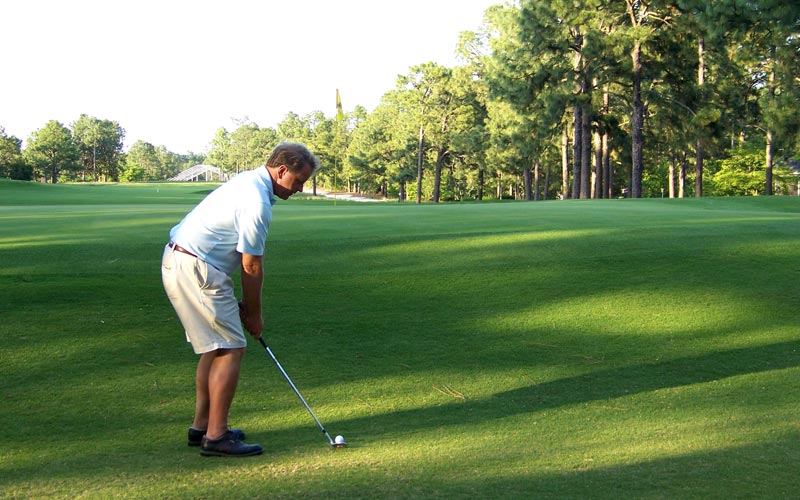
Plenty of golfers reach around the fifteenth green in two blows; whether they get up and down for birdie is now a trickier proposition.
Eighteenth hole, 420/405 yards; Today’s Home hole was originally the course’s first and it make some wonder: has there ever been a better architect at designing first holes? Probably not. Just in Pinehurst, there are three superior ones and that’s before one starts to consider Plainfield and French Lick and Inverness and Salem and Essex and Hogan’s favorite at Oak Hill, etc. Ross clearly liked to set the tone early. As it is, this hole perfectly captures the charm of Pine Needles, and thus makes for a great closing hole. Also, it is a bit of a rarity for a Home hole as it plays downhill; most clubs are fixated with having the clubhouse on high ground which invariably means most Home holes play uphill. Judging where to land one’s approach so that it will release close to the day’s hole location is a shot that one never tires of playing.
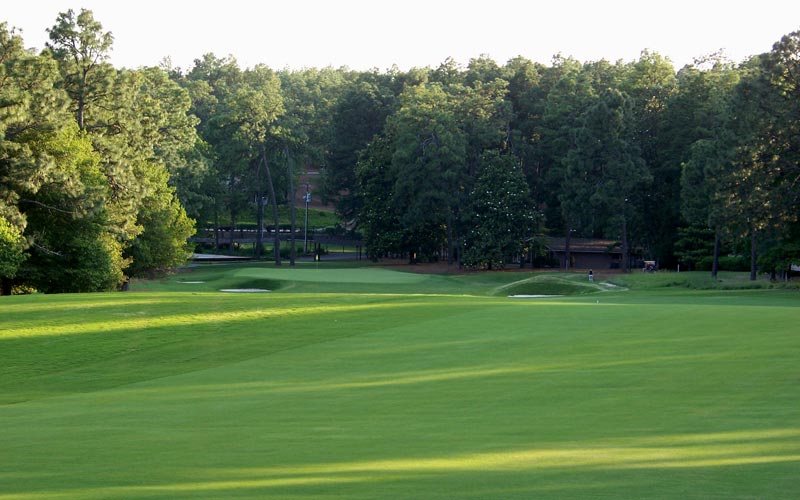
The appealing broad sweep of the Home fairway as it turns downhill to the green. Typical for a Ross design, the skilled player is free to seek an advantage, this time by drawing his tee shot down the right to left sloping fairway.
More so than almost any other course, most people can’t help but head straight for the nearby practice field afterwards. There was always some shot out on the course that one should have played but may not have been comfortable in doing so, and this practice area is the perfect place to develop that shot. The dead level hitting area and white balls to a huge, uncluttered field is where the serious golfer happily spends hours and hours.

The view from the eighteenth fairway is across the first tee and practice putting green and to the practice area itself.
Pine Needles was a planned housing development from the start and was always intended to be the bigger, stronger of the two courses. Unfortunately, it opened late in 1928. The Great Depression took its toll on the Pinehurst community one year later and both courses were sold to take financial strain off the Pinehurst Resort. The fate of these two Ross courses hung in the balance.
Fortuitously, Pine Needles was purchased in 1953 by Warren and Peggy Kirk Bell. Mrs. Bell was one of the founders of the LPGA Tour and knew Donald Ross. Their first meeting occurred almost sixty years ago, when she drove from her home in Florida to Pinehurst. Mrs. Bell arrived unannounced hoping to play in the tournament that week. The first person that she met was one Mr. Donald Ross who politely informed her that the tournament was by invitation only. Disconsolate, she sat at a nearby table and prepared for the long drive home whereupon Ross re-appeared and extended on the spot an invitation to play. Such began a warm relationship between the Bells and their fondness for the Pinehurst area and for Donald Ross.
Nearly forty years after acquiring Pine Needles, the Bell family was also involved in the acquisition of Mid Pines, and thus the two courses are once again linked by a common ownership which understands golf. The family run resort of Pine Needles and Mid Pines is a throwback to when golf was a simpler game without the peripheral distractions that clutter many resorts in the United States. After a round on either course, one is inspired rather than exhausted. Golf, as it was meant to be, indeed.
The End



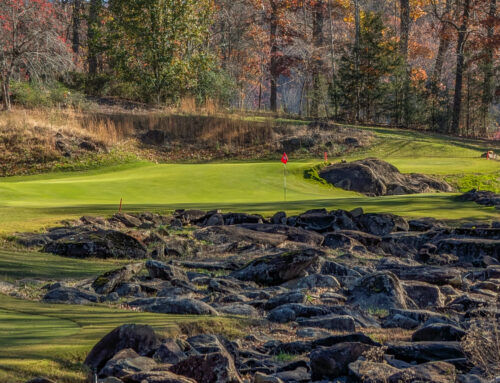
![The Park, West Palm (Lit 9) [2023]](https://golfclubatlas.com/wp-content/uploads/2024/12/IMG_7092-2-scaled-500x383.jpg)
